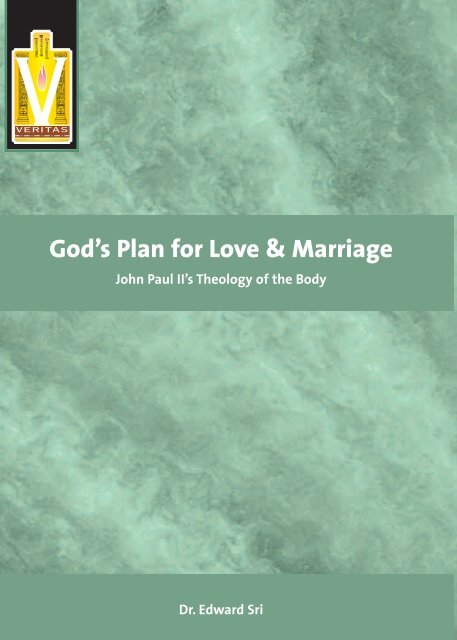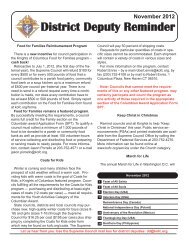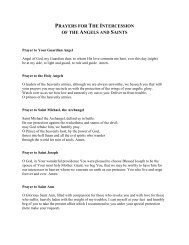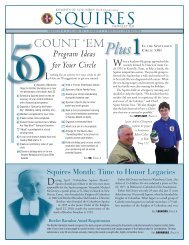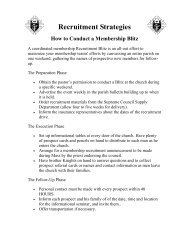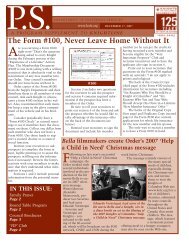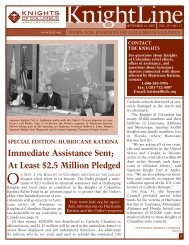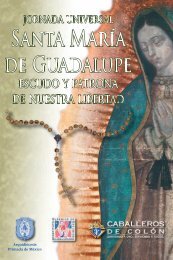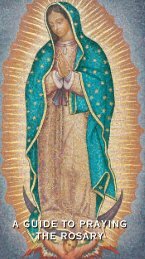God's Plan for Love & Marriage - Knights of Columbus, Supreme ...
God's Plan for Love & Marriage - Knights of Columbus, Supreme ...
God's Plan for Love & Marriage - Knights of Columbus, Supreme ...
You also want an ePaper? Increase the reach of your titles
YUMPU automatically turns print PDFs into web optimized ePapers that Google loves.
VVERITAS<br />
God’s <strong>Plan</strong> <strong>for</strong> <strong>Love</strong> & <strong>Marriage</strong><br />
John Paul II’s Theology <strong>of</strong> the Body<br />
Dr. Edward Sri
The <strong>Knights</strong> <strong>of</strong> <strong>Columbus</strong> presents<br />
The Veritas Series<br />
“Proclaiming the Faith in the Third Millennium”<br />
God’s <strong>Plan</strong> <strong>for</strong> <strong>Love</strong> and <strong>Marriage</strong><br />
John Paul II’s “Theology <strong>of</strong> the Body”<br />
BY<br />
DR. EDWARD SRI<br />
General Editor<br />
Father Juan-Diego Brunetta, O.P.<br />
Director <strong>of</strong> the Catholic In<strong>for</strong>mation Service<br />
<strong>Knights</strong> <strong>of</strong> <strong>Columbus</strong> <strong>Supreme</strong> Council
Nihil Obstat<br />
William C. Beckman, M.T.S.<br />
Censor Librorum<br />
Imprimatur<br />
Most Reverend Charles J. Chaput, O.F.M.<br />
Archbishop <strong>of</strong> Denver<br />
September 10, 2008<br />
© 2008 by <strong>Knights</strong> <strong>of</strong> <strong>Columbus</strong> <strong>Supreme</strong> Council. All rights reserved.<br />
Cover: 2008 <strong>Knights</strong> <strong>of</strong> <strong>Columbus</strong> <strong>Supreme</strong> Council. All rights reserved.<br />
This booklet is derived from a chapter in Edward Sri’s Men, Women and the Mystery <strong>of</strong><br />
<strong>Love</strong>: Practical Insights from John Paul II’s “<strong>Love</strong> and Responsibility” (Cincinnati: Servant<br />
Books, 2007).<br />
No part <strong>of</strong> this book may be reproduced or transmitted in any <strong>for</strong>m or by any means,<br />
electronic or mechanical, including photocopying, recording, or by in<strong>for</strong>mation<br />
storage and retrieval system, without permission in writing from the publisher.<br />
Write:<br />
Catholic In<strong>for</strong>mation Service<br />
<strong>Knights</strong> <strong>of</strong> <strong>Columbus</strong> <strong>Supreme</strong> Council<br />
PO Box 1971<br />
New Haven CT 06521-1971<br />
cis@k<strong>of</strong>c.org<br />
www.k<strong>of</strong>c.org/cis<br />
203-752-4267<br />
203-752-4018 fax<br />
Printed in the United States <strong>of</strong> America
CONTENTS<br />
INTRODUCTION. . . . . . . . . . . . . . . . . . . . . . . . . . . . . . . . . . . . . 5<br />
SELF-GIVING LOVE . . . . . . . . . . . . . . . . . . . . . . . . . . . . . . . . . . 7<br />
ORIGINAL SOLITUDE . . . . . . . . . . . . . . . . . . . . . . . . . . . . . . . . . 8<br />
ORIGINAL UNITY . . . . . . . . . . . . . . . . . . . . . . . . . . . . . . . . . . . . 9<br />
ORIGINAL NAKEDNESS . . . . . . . . . . . . . . . . . . . . . . . . . . . . . . . 11<br />
ORIGINAL SHAME . . . . . . . . . . . . . . . . . . . . . . . . . . . . . . . . . . . 13<br />
BACK TO THE GARDEN . . . . . . . . . . . . . . . . . . . . . . . . . . . . . . . 15<br />
A CATHOLIC PRAYER FOR MARRIED COUPLES . . . . . . . . . . . . . . 18<br />
REFLECTION QUESTIONS . . . . . . . . . . . . . . . . . . . . . . . . . . . . . . 19<br />
FOR FURTHER READING . . . . . . . . . . . . . . . . . . . . . . . . . . . . . . 20<br />
ABOUT THE AUTHOR . . . . . . . . . . . . . . . . . . . . . . . . . . . . . . . . 22<br />
- 3 -
- 4 -
GOD’S PLAN FOR LOVE AND MARRIAGE:<br />
JOHN PAUL II’S “THEOLOGY OF THE BODY”<br />
BY EDWARD SRI<br />
<strong>Marriage</strong> is not an easy endeavor, especially in our culture<br />
today. Many men and women may go into marriage with much<br />
excitement, but also with some uncertainty or trepidation about<br />
how to be a good husband or wife, a good father or mother. Even<br />
couples with the best <strong>of</strong> intentions may find themselves eventually<br />
struggling in their marriages and wondering why their relationship<br />
with their spouse didn’t turn out the way they had hoped.<br />
Just consider how widespread the crisis in marriage is today.<br />
On one hand, it is <strong>of</strong>ten pointed out that about half <strong>of</strong> all marriages<br />
end in divorce. This is indeed a devastating statistic, as so many<br />
people (parents and children alike) have felt the pain and heartache<br />
<strong>of</strong> divorce in the modern world.<br />
On the other hand, while the 50% divorce rate is tragic, what<br />
is not <strong>of</strong>ten discussed is the other half <strong>of</strong> marriage, which I like to<br />
call “the other 50 percent”—those married couples who actually<br />
stay together. How are those marriages doing? Are those<br />
relationships thriving? Among the couples that are still together,<br />
are those husbands and wives really happy in their marriage? Do<br />
they experience deep intimacy, trust and security with their spouse?<br />
Day-in and day-out, do their relationships reflect the total,<br />
committed, sacrificial love <strong>of</strong> Jesus Christ?<br />
The picture even <strong>of</strong> the marriages that remain intact is not<br />
<strong>of</strong>ten a pretty one. Studies have shown that most married couples do<br />
not feel close to each other. In fact, only about 12% <strong>of</strong> all married<br />
couples say they experience emotional intimacy with their spouse.<br />
- 5 -
Feel the weight <strong>of</strong> that: About half <strong>of</strong> all marriages end in<br />
divorce, but even among couples who are still together, only about<br />
12% feel close to the person they married. <strong>Marriage</strong> is in trouble,<br />
indeed! We must remember that a good marriage is not one that<br />
merely stays together. (Imagine asking a man on his 20 th wedding<br />
anniversary how his marriage is going and him saying, “It’s going<br />
great. We haven’t divorced yet!”). Rather, a good marriage reflects<br />
the total, self-less, sacrificial love <strong>of</strong> Jesus Christ. A good marriage<br />
is one that builds deep trust and intimacy. A good marriage is one<br />
in which husband and wife can look each other in the eye 10, 20,<br />
30 years into their marriage and say “I love you more now than I<br />
did when we were first married.” That’s the kind <strong>of</strong> marriage we<br />
want to shoot <strong>for</strong> in life—not just one that simply stays together.<br />
In an age when there is much confusion about what love truly<br />
is and what it really takes to make a strong marriage, Pope John Paul<br />
II dedicated much <strong>of</strong> his life to casting a vision <strong>for</strong> how great marriage<br />
is meant to be. And he <strong>of</strong>fered us a beautiful picture <strong>of</strong> love, marriage<br />
and sexuality that is very different from what the world teaches us,<br />
but one that is truly life-trans<strong>for</strong>ming if taken to heart.<br />
Some <strong>of</strong> the most pr<strong>of</strong>ound teaching he gave on love and<br />
marriage is known as the “Theology <strong>of</strong> the Body”— a set <strong>of</strong> 129<br />
catechetical addresses he gave in Rome between 1979-1984, which<br />
have revolutionized the way many theologians and catechists now<br />
teach about love, sexuality and marriage.<br />
However, while some lay Catholics may respond initially with<br />
enthusiasm to the ideas they’ve heard about the Theology <strong>of</strong> the Body,<br />
many <strong>of</strong> those who actually dare to read these addresses quickly find<br />
themselves overwhelmed by the depth <strong>of</strong> John Paul II’s philosophical,<br />
theological and indeed, mystical thought on this topic.<br />
In this short booklet, I will look at five key points from the<br />
Theology <strong>of</strong> the Body, focusing primarily on John Paul II’s<br />
- 6 -
eflections on what marriage originally was intended to be. While I<br />
am not intending to <strong>of</strong>fer a comprehensive overview, it is my hope<br />
that a short tour through these five fundamental points will help<br />
make John Paul II’s monumental work on the Theology <strong>of</strong> the Body<br />
a bit more digestible and practical <strong>for</strong> married life.<br />
1. SELF-GIVING LOVE<br />
The most essential aspect <strong>of</strong> love that every marriage needs is<br />
what John Paul II calls “self-giving”. Near the beginning <strong>of</strong> the<br />
Theology <strong>of</strong> the Body, he alludes to this point while reflecting on<br />
God’s words at the creation <strong>of</strong> Adam and Eve: “Let us create man in<br />
our image and after our likeness” (Genesis 1:26). This verse tells us<br />
God created human persons to mirror His own inner life, which is<br />
all about total, self-giving love. God, as the Trinity, exists as a<br />
communion <strong>of</strong> three divine Persons (Father, Son and Holy Spirit)<br />
giving themselves completely in love to each other. And God<br />
created man and woman “in his image” to reflect that intimate,<br />
loving communion in their own lives. Created in the image <strong>of</strong> God,<br />
we were made to live like the Trinity, which means we were made<br />
<strong>for</strong> relationships <strong>of</strong> love. It’s only when we give ourselves in love to<br />
others (thus mirroring the life <strong>of</strong> the Trinity), that we will find the<br />
happiness we long <strong>for</strong>.<br />
The attitude that erodes a marriage and keeps couples from<br />
experiencing deep unity and trust in their relationship is selfishness.<br />
Selfishness is the very opposite <strong>of</strong> the self-giving love we are made<br />
<strong>for</strong>. This is an important message <strong>for</strong> our times, <strong>for</strong> we live in an era<br />
that encourages us to approach our relationships as ways <strong>of</strong> seeking<br />
our own pleasure, com<strong>for</strong>t, interests or gain. Especially in marriage,<br />
there is a temptation to want our spouse (and our children) to<br />
con<strong>for</strong>m to our own plans, schedules and preferences, and we<br />
become easily frustrated when they do not. This kind <strong>of</strong> attitude<br />
could be called “self-getting love”—a love centered on self, in which<br />
- 7 -
we constantly ask “What do I get out <strong>of</strong> the relationship?” For<br />
example, even among devout Christians, a selfishness can creep into<br />
a marriage that gets me to focus more on what I need (as opposed<br />
to what my spouse may need), on what I want to do with my time<br />
on the weekend (as opposed to using my time to help my spouse<br />
and children), or on what I want (or don’t want) to spend money on<br />
(as opposed to what is best <strong>for</strong> others in my family).<br />
John Paul II constantly reminded us that such self-seeking is<br />
a dead end that will never lead to the love and happiness we long<br />
<strong>for</strong> in marriage. Human persons were made <strong>for</strong> self-giving love—a<br />
love that selflessly seeks what is best <strong>for</strong> the other person. It is a<br />
sacrificial love that pursues what is good <strong>for</strong> one’s beloved, <strong>for</strong> one’s<br />
marriage and <strong>for</strong> one’s family more than it pursues one’s own<br />
preferences, interests, pleasures or com<strong>for</strong>ts in life. In the end,<br />
human persons were made <strong>for</strong> self-giving love, not a self-getting love,<br />
and they will find fulfillment only when they give themselves in<br />
service to others.<br />
2. ORIGINAL SOLITUDE<br />
Now, let us go back to the Garden <strong>of</strong> Eden and consider God’s<br />
original plan <strong>for</strong> marriage and the pr<strong>of</strong>ound unity He intended man<br />
and woman to experience in self-giving love.<br />
God created Adam in his image and likeness, and as we’ve<br />
seen, this indicates that Adam is made to live like the Trinity in a<br />
relationship <strong>of</strong> self-giving love. Next, John Paul II reflects on God’s<br />
interesting statement about Adam in Genesis 2:18: “It is not good<br />
<strong>for</strong> man to be alone.”<br />
At first glance, this statement seems odd. According to the<br />
narrative <strong>of</strong> Genesis 2, Adam is not alone. God has placed him in a<br />
garden with water, trees, and vegetation. He has even put Adam<br />
alongside other flesh and blood creatures—the animals. Even<br />
- 8 -
though there are many other animal creatures with bodies just like<br />
him in the Garden <strong>of</strong> Eden, Adam is still in some sense described<br />
as being “alone.”<br />
This tells us that there is something about Adam that is not<br />
found in other bodily creatures. By noticing how he is different from<br />
the animals, Adam comes to realize that he is more than a body—<br />
that he has a spiritual dimension, a soul. As a body-soul creature,<br />
Adam is unique. There is nothing else in creation like him.<br />
And this poses a problem. If Adam is made to live self-giving<br />
love—to give himself in a mutual relationship <strong>of</strong> love—then Adam,<br />
at this stage, is in a certain sense incomplete. He is not able to do<br />
this yet, <strong>for</strong> there is no one else like him to give himself to as an<br />
equal partner. There is no other human person, no body-soul<br />
creature, like him. This is why God says, “It is not good <strong>for</strong> man to<br />
be alone.”<br />
John Paul II explains that man only finds fulfillment when he<br />
lives in a relationship <strong>of</strong> mutual self-giving, living not <strong>for</strong> himself,<br />
but <strong>for</strong> another person. “When God-Yahweh says, ‘It is not good<br />
that man should be alone” (Genesis 2:18), he affirms that ‘alone,’<br />
the man does not completely realize this essence. He realizes it only<br />
by existing ‘with someone’—and put even more deeply and<br />
completely—by existing ‘<strong>for</strong> someone’” (p. 182). 1<br />
3. ORIGINAL UNITY<br />
In response to Adam’s solitude, the Lord creates another<br />
human person, Eve, to be his wife. “Then the man said, ‘This at last<br />
is bone <strong>of</strong> my bones and flesh <strong>of</strong> my flesh” (Genesis 2:23). John Paul<br />
II notes how this is the first time man manifests joy and exaltation.<br />
1 All page references are taken from John Paul II, Man and Woman He Created Them: A Theology <strong>of</strong><br />
the Body (Boston: Daughters <strong>of</strong> St. Paul, 2006).<br />
- 9 -
Be<strong>for</strong>e this moment, he had no reason <strong>for</strong> rejoicing, “owing to the<br />
lack <strong>of</strong> a being similar to himself” (p. 161). But now he finally has<br />
someone to give himself to in this unique way. In ecstatic response,<br />
he sighs “At last!,” <strong>for</strong> now he is able to live out the self-giving love<br />
he was made <strong>for</strong>, and thus he becomes who he was meant to be<br />
through his union with her.<br />
Next, John Paul II reflects on how man and woman “become<br />
one flesh” (Genesis 2:24). He notes how this oneness in flesh does<br />
not refer merely to a bodily union, but points to a deeper spiritual<br />
union, a union <strong>of</strong> persons.<br />
Recall how a human person is not just a body, but consists <strong>of</strong><br />
body and soul. John Paul II expounds on how this union <strong>of</strong> body<br />
and soul in a person sheds light on human sexuality. The body has<br />
a language that is able to communicate something much more<br />
pr<strong>of</strong>ound than in<strong>for</strong>mation or ideas. What one does in his body<br />
reveals his very self, the “living soul” (p. 183). The body expresses<br />
the person and makes visible what is invisible, the spiritual<br />
dimension <strong>of</strong> man (pp. 176, 203).<br />
This has dramatic implications <strong>for</strong> understanding sexual<br />
intercourse. The marital act is not meant to be merely a physical<br />
union. It is meant to express an even deeper personal union. Since<br />
the body reveals the soul, when man and woman give their bodies<br />
to each other in marital intercourse, they give themselves to each<br />
other. Bodily union is meant to express a deeper spiritual union.<br />
The physical intimacy is meant to express an even more pr<strong>of</strong>ound<br />
personal intimacy (cf., p. 176).<br />
John Paul II calls this unique language <strong>of</strong> the body “the<br />
spousal meaning <strong>of</strong> the body.” This means that our bodies have a<br />
marital significance in the sense that they have “the power to express<br />
love: precisely that love in which the human person becomes a gift and—<br />
- 10 -
through this gift—fulfills the very meaning <strong>of</strong> his being and<br />
existence.” (pp. 185-6).<br />
In this light, we can see that the body will be an important<br />
arena in which the drama <strong>of</strong> relationships between men and women<br />
will be played out—<strong>for</strong> better or <strong>for</strong> worse. We can approach the<br />
bodily union <strong>of</strong> sexual intercourse as a means to deepening personal<br />
communion in marriage. Or we can engage in sexual intercourse<br />
primarily with our own pleasure in mind and without any regard<br />
<strong>for</strong> the body’s capacity to express self-giving love—in other words,<br />
without any regard <strong>for</strong> spousal meaning God has given to the body.<br />
Put starkly: A man can view sex as a way <strong>of</strong> deepening his<br />
personal union with his wife, giving himself completely to her and<br />
expressing his total commitment to her as a person and to what is<br />
best <strong>for</strong> her. Or he can approach sex merely as a physical act with<br />
some woman who happens to gives him pleasure—without any real<br />
commitment to that woman’s well-being. Instead <strong>of</strong> being truly<br />
committed to the woman as a person and to her good, such a man is<br />
committed to the woman in that moment primarily <strong>for</strong> what she<br />
provides him: his own sexual satisfaction. This denigration <strong>of</strong> sex,<br />
which is pervasive in our culture today, certainly is a far cry from the<br />
beautiful “spousal meaning” God has given to the body.<br />
4. ORIGINAL NAKEDNESS<br />
Next, John Paul II addresses a crucial aspect <strong>of</strong> the theology <strong>of</strong><br />
the body—a fundamental concept that he calls “Original<br />
Nakedness.” What does it mean when Genesis 2:25 says Adam and<br />
Eve were “naked and not ashamed”? Shame involves fear <strong>of</strong> another<br />
person, when we’re not sure we can trust that person. We fear being<br />
used or being hurt, so we are afraid <strong>of</strong> being vulnerable in letting<br />
others see us as we really are.<br />
- 11 -
Originally, Adam and Eve were not ashamed. They each had<br />
complete confidence, trust and security in their relationship. Their<br />
bodily nakedness pointed to an even deeper personal “nakedness”, in<br />
which they felt free to bear their souls completely to each other<br />
without any fear <strong>of</strong> being used, misunderstood or let down. Adam<br />
and Eve understood “the spousal meaning <strong>of</strong> the body”—not just<br />
the body at face value, but the body’s capacity to express love and<br />
the communion <strong>of</strong> persons.<br />
How were they able to have this ideal relationship?<br />
Imagine living in a relationship in which there was absolutely<br />
no selfishness. You knew that your beloved was always seeking what<br />
was best <strong>for</strong> you, and not just his own interests. He truly viewed<br />
you as a gift that was uniquely entrusted to him and he took this<br />
role seriously with a pr<strong>of</strong>ound sense <strong>of</strong> responsibility<br />
This is the kind <strong>of</strong> relationship Adam and Eve had in the<br />
garden. Be<strong>for</strong>e the fall, sin had not yet entered the world and human<br />
persons had self-mastery over their passions and appetites. Thus,<br />
with total purity <strong>of</strong> heart, they each were free from selfish desires<br />
and approached each other with reverence, seeking the good <strong>of</strong> the<br />
other and never viewing the other merely as an object to be used.<br />
John Paul II explains that Adam and Eve saw each other with<br />
a supernatural perspective—with “the vision <strong>of</strong> the Creator himself”<br />
(p. 157). In other words, they saw each other the way God Himself<br />
saw them. Adam saw not just the beauty <strong>of</strong> Eve’s body, but the<br />
whole truth <strong>of</strong> his beloved as a person. And just as God rejoiced in<br />
creating man and woman by saying, “It is good!,” so would Adam<br />
have looked upon his wife with a pr<strong>of</strong>ound sense <strong>of</strong> awe and wonder,<br />
seeing her as the daughter <strong>of</strong> God who had entrusted herself to him<br />
in marriage.<br />
- 12 -
It is as if Adam realized he was holding his wife’s heart in the<br />
palm <strong>of</strong> his hand. Feeling the magnitude <strong>of</strong> the gift that was<br />
entrusted to him, Adam would have been so careful with every<br />
word and with every interaction with Eve, always attentive to her<br />
needs and gently avoiding anything that would in the slightest bit<br />
hurt her. Likewise, Eve would have welcomed Adam as a gift and<br />
responded to him with a tremendous sense <strong>of</strong> responsibility to care<br />
<strong>for</strong> whatever was best <strong>for</strong> her husband. “Seeing each other<br />
reciprocally, through the very mystery <strong>of</strong> creation as it were, the<br />
man and woman see each other still more fully and clearly than<br />
through the sense <strong>of</strong> sight itself…They see and know each other, in<br />
fact, with all the peace <strong>of</strong> the interior gaze, which creates precisely<br />
the fullness <strong>of</strong> the intimacy <strong>of</strong> persons” (pp. 177-8).<br />
In this kind <strong>of</strong> environment <strong>of</strong> complete, mutual love and<br />
responsibility, personal intimacy could flourish. In such a<br />
relationship <strong>of</strong> total security and total trust in the other person—<br />
when there is no fear <strong>of</strong> being used or hurt—one feels free to give<br />
himself as he really is, knowing that he will be welcomed and fully<br />
received as a gift. “The ‘affirmation <strong>of</strong> the person’ is nothing other<br />
than welcoming the gift, which…creates the communion <strong>of</strong><br />
persons” (p. 188). Thus, originally man and woman did not<br />
experience the walls <strong>of</strong> shame in their relationship. They had no fear<br />
that the other would use them, hurt them or ever reject them. Free<br />
from sin, they were free to love. In a relationship <strong>of</strong> total reciprocal<br />
love, the walls <strong>of</strong> shame are not necessary. Indeed, as John Paul II<br />
explains, “immunity from shame” is “the result <strong>of</strong> love” (p. 191).<br />
5. ORIGINAL SHAME<br />
However, once sin entered the world, man lost the selfmastery<br />
necessary to keep selfish desires from growing in his heart<br />
and poisoning his relationship. Wounded by original sin, man finds<br />
that it is no longer easy <strong>for</strong> him to control his passions and appetites.<br />
- 13 -
No longer does man easily look upon his wife with “the vision <strong>of</strong><br />
the Creator” (“It is good!”). No longer does he easily see her as a<br />
person who has been entrusted to him and as a gift which he longs<br />
to serve with selfless love and responsibility.<br />
Now his heart is tainted by selfishness, as he notices himself<br />
pursing his own desires and preferences instead <strong>of</strong> seeking her well<br />
being first. His love <strong>for</strong> his wife is stained by desires to use her. He<br />
even begins to view her primarily in terms <strong>of</strong> her sexual value—the<br />
value <strong>of</strong> her body or the value <strong>of</strong> her femininity—as an object to be<br />
exploited <strong>for</strong> his own sensual or emotional pleasure. In sum, he no<br />
longer easily sees her value as a person to be loved <strong>for</strong> her own sake.<br />
Indeed, this selfishness and lust cannot be overcome without the<br />
grace <strong>of</strong> God.<br />
Imagine the shock Adam must have experienced at that first<br />
moment in which he felt the effects <strong>of</strong> original sin in his life. John<br />
Paul II says it is as if Adam “experienced that he had simply<br />
ceased…to remain above the world <strong>of</strong>” animals, which are driven by<br />
instinct and desires (TOB, p. 245). Almost like the animals, Adam<br />
now finds himself powerfully swayed by his desire to satisfy his own<br />
sexual desires, rather than serve his beloved’s good.<br />
No longer mastering their passions, man and woman tend to<br />
approach each other with selfish and lustful hearts. That’s why<br />
Adam and Eve instinctively conceal their sexuality from each other<br />
the moment sin and lust enters their lives. They each no longer have<br />
total trust that the other is truly seeking what is best <strong>for</strong> them. They<br />
instinctively know that their beloved may use them. Thus, the<br />
Biblical account <strong>of</strong> the fall tells us that right after Adam and Eve<br />
sinned in the garden, they were “naked and ashamed” (Genesis 3:7).<br />
The introduction <strong>of</strong> sin shatters the original unity <strong>of</strong> man and<br />
woman and hinders personal intimacy in their relationship, <strong>for</strong> now<br />
the defense mechanism <strong>of</strong> shame enters their relationship. Shame<br />
- 14 -
“replaced the absolute trust connected with the earlier state <strong>of</strong><br />
original innocence in the reciprocal relationship between man and<br />
woman” (p. 250).<br />
John Paul II explains that the original unity <strong>of</strong> Adam and Eve<br />
dissolved at the Fall because without the total, mutual, selfless love<br />
and trust, they no longer felt free to truly give themselves to each<br />
other: “Obviously, the first parents did not stop communicating<br />
with each other through the body and its movements, gestures, and<br />
expressions; but what disappeared was the simple and direct selfcommunion<br />
connected with the original experience <strong>of</strong> reciprocal<br />
nakedness. Almost unexpectedly, an insurmountable threshold<br />
appeared in their consciousness that limited the original ‘selfdonation’<br />
to their other with full trust in all that constituted one’s<br />
identity…” (p. 247).<br />
BACK TO THE GARDEN?<br />
In closing, let’s consider some practical ways we can<br />
strengthen our spousal union to live out more fully God’s original<br />
plan <strong>for</strong> marriage.<br />
First, knowing is half the battle. Simply becoming more aware<br />
<strong>of</strong> God’s plan <strong>for</strong> marriage helps us to evaluate our own lives,<br />
inspires us to be better husbands and wives and helps enkindle a<br />
desire to build stronger, deeper marriages. That’s why it is so<br />
important to study the rich Catholic vision <strong>for</strong> marriage and family<br />
life—a vision that is very different from what the world has to say<br />
about these matters. Especially in an era when there is so much<br />
confusion about love, about marriage and about how to be a good<br />
husband and wife, we must go out <strong>of</strong> our way to take time to<br />
discover more about God’s plan <strong>for</strong> marriage. If we are not<br />
proactive—if we do not make it a priority to <strong>for</strong>m our minds in the<br />
Catholic vision <strong>for</strong> marriage and family life—we will end up<br />
- 15 -
following the ways <strong>of</strong> the world, which too <strong>of</strong>ten lead to<br />
disappointment, loneliness and heartache with the one person on<br />
earth we were meant to be closest to. Below, there are some<br />
recommended resources <strong>for</strong> feeding our minds on the Theology <strong>of</strong><br />
the Body and good Catholic perspectives on marriage and family<br />
life that can help us build the kind <strong>of</strong> marriages God wants us to<br />
have.<br />
Second, we must be patient with ourselves—and with our<br />
spouse! Years <strong>of</strong> selfishness in our own hearts and patterns <strong>of</strong><br />
behavior and relating to each other are not going to be changed<br />
overnight. In fact, as sinful creatures constantly battling<br />
concupiscence (the disordered appetites and desires resulting<br />
from original sin that produce an inclination toward sin) 2 , we<br />
will never be able to return to the ideal relationship <strong>of</strong> pre-fallen<br />
Adam and Eve.<br />
However, there is hope. Through Christ’s redemptive work in<br />
our lives, we will begin to experience the healing <strong>of</strong> those selfish<br />
passions that keep us from the great trust, love and personal<br />
communion that God wants us to experience in our relationships.<br />
And we can access this healing power <strong>of</strong> God’s love in the Church<br />
through prayer and the sacraments. In the Sacrament <strong>of</strong><br />
Reconciliation especially, we can examine the ways our selfishness<br />
affects our marriage, seek God’s <strong>for</strong>giveness and receive grace to help<br />
us overcome those sins in the future. Going to confession once a<br />
month, <strong>for</strong> example, can have a huge impact in our marriages.<br />
There is hope even <strong>for</strong> marriages in crisis. First, we must<br />
remember the life-long vow we made to our spouse on our wedding<br />
day: “I promise to be true to you in good times and in bad, in<br />
sickness and in health. I will love you and honor you all the days <strong>of</strong><br />
2 See 1 John 2:16 and Catechism <strong>of</strong> the Catholic Church, 405, 1264, 1426, 2515.<br />
- 16 -
my life.” Second, we may need to seek outside help to salvage a<br />
marriage that’s heading toward disaster. Many couples have<br />
benefited from good marriage counseling or seeking guidance from<br />
a priest. Others have benefited from movements such as “<strong>Marriage</strong><br />
Encounter”—a weekend retreat that has served 2.5 million couples,<br />
80% <strong>of</strong> whom have said the retreat helped them “fall back in love”<br />
and gain new respect <strong>for</strong> their spouse. One Catholic marriage<br />
ministry that <strong>of</strong>fers parish seminars, marriage “coaching” and many<br />
resources is Alexander House. They even <strong>of</strong>fer marriage coaching<br />
over the phone <strong>for</strong> couples around the world, whether it be <strong>for</strong><br />
marriage preparation, marriages in crisis or couples simply wanting<br />
to strengthen their union in Christ. For more in<strong>for</strong>mation, see<br />
http://www.thealexanderhouse.org/colinfo.htm.<br />
Finally, all married people—whether they are thriving or<br />
struggling in their marriages—need to pray. Certainly, we should<br />
pray <strong>for</strong> our marriage. We should pray <strong>for</strong> our spouse, and we should<br />
even pray with our spouse. Below you will find some recommended<br />
guides on prayer as well as a prayer that spouses can recite together<br />
<strong>for</strong> their marriage. But most <strong>of</strong> all, we need to pray <strong>for</strong> ourselves that<br />
we may grow in deeper union with Jesus, so that Christ’s love<br />
begins to radiate through us in all our words and actions with<br />
others, especially our spouse. With my own weak, impatient,<br />
prideful, selfish self, I am not able to love my wife the way I would<br />
like to. However, by living deeply in union with Jesus Christ, I can<br />
begin to love with Christ’s love. The more the Holy Spirit<br />
trans<strong>for</strong>ms our selfish hearts with the total self-giving love <strong>of</strong> Jesus<br />
Christ, the more our relationships will begin to recover something<br />
<strong>of</strong> the original unity <strong>of</strong> man and woman and the spousal meaning<br />
<strong>of</strong> the body that John Paul II so beautifully described.<br />
- 17 -
A CATHOLIC PRAYER FOR MARRIED COUPLES<br />
Lord Jesus,<br />
grant that I and my spouse may have a true<br />
and understanding love <strong>for</strong> each other.<br />
Grant that we may both<br />
be filled with faith and trust.<br />
Give us the grace to live<br />
with each other in peace and harmony.<br />
May we always bear with one another's weaknesses<br />
and grow from each other's strengths.<br />
Help us to <strong>for</strong>give one another's failings<br />
and grant us patience, kindness, cheerfulness<br />
and the spirit <strong>of</strong> placing the well-being<br />
<strong>of</strong> one another ahead <strong>of</strong> self.<br />
May the love that brought us together<br />
grow and mature with each passing year.<br />
Bring us both ever closer to You<br />
through our love <strong>for</strong> each other.<br />
Let our love grow to perfection.<br />
Amen. 3<br />
3 Accessed at: http://img.soulmatch.com/prayer<strong>of</strong>theday/more_prayers.asp?paid=57&faid=1<br />
- 18 -
REFLECTION QUESTIONS<br />
1. Our modern world <strong>of</strong>ten views love primarily in terms <strong>of</strong><br />
one’s own feelings. John Paul II stresses that real love<br />
consists <strong>of</strong> “self-giving.” What is self-giving love, and how<br />
is it different from modern notions <strong>of</strong> love?<br />
2. What are some specific ways you tend to focus on your own<br />
desires and preferences instead <strong>of</strong> serving the needs <strong>of</strong> your<br />
spouse and children? In other words, what are some ways<br />
you fall into selfishness in your marriage<br />
3. Think about your relationship with your spouse and<br />
moments or areas in your life where you have been selfish,<br />
focusing more on your own interests and goals than on your<br />
beloved’s needs and well-being. How has your selfishness<br />
affected your relationship with your spouse? Give some specific<br />
examples.<br />
4. What are some specific things you can do to focus more on<br />
the good <strong>of</strong> your spouse in your marriage? How do you think<br />
that would affect your relationship if you did these things?<br />
5. Why was it not good <strong>for</strong> Adam to be alone? Was it simply<br />
because he was lonely? Explain.<br />
6. Explain what John Paul II means by “the spousal meaning<br />
<strong>of</strong> the body.” In light <strong>of</strong> the spousal meaning <strong>of</strong> the body,<br />
what is the pr<strong>of</strong>ound significance <strong>of</strong> marital intercourse? In<br />
other words, what is the marital act meant to communicate?<br />
7. What kind <strong>of</strong> unity did Adam and Eve have originally,<br />
be<strong>for</strong>e sin entered the world? Why were they able to have<br />
such a pr<strong>of</strong>ound intimacy and trust with each other?<br />
8. What are some practical resolutions you can make to help<br />
you build greater intimacy and trust in your marriage?<br />
- 19 -
RECOMMENDED RESOURCES<br />
1<br />
Edward Sri, Men, Women and the Mystery <strong>of</strong> <strong>Love</strong>: Practical Insights<br />
from John Paul II’s ‘<strong>Love</strong> and Responsibility’ (Cincinnati: Servant<br />
Books, 2007).<br />
2<br />
Karol Wojtyla, <strong>Love</strong> and Responsibility (San Francisco: Ignatius<br />
Press, 1993).<br />
3<br />
John Paul II, Man and Woman He Created Them: A Theology <strong>of</strong> the<br />
Body (Boston: Pauline Books & Media, 2006).<br />
4<br />
Mary Healy, Men & Women are from Eden: A Study Guide to John<br />
Paul II’s Theology <strong>of</strong> the Body (Cincinnati: Servant Books, 2005).<br />
5<br />
Mary Shivanandan, Crossing the Threshold <strong>of</strong> <strong>Love</strong> (Washington:<br />
Catholic University Press, 2002).<br />
6<br />
Carl Anderson and Fr. Jose Granados, Called to <strong>Love</strong> —<br />
Approaching John Paul II’s Theology <strong>of</strong> the Body (Doubleday, 2009).<br />
7<br />
Jason & Crystalina Evert and Brian Butler, Theology <strong>of</strong> the Body <strong>for</strong><br />
Teens (West Chester, PA: Ascension Press, 2006).<br />
8<br />
George Weigel, “How Should We <strong>Love</strong>?” chapter in The Truth <strong>of</strong><br />
Catholicism (New York: HarperCollins, 2001), pp. 92-111.<br />
9<br />
George Weigel, Witness to Hope: The Biography <strong>of</strong> Pope John Paul II<br />
(New York: HarperCollins, 1999), pp. 335-43 (Historical<br />
background and explanation <strong>of</strong> John Paul II’s “Theology <strong>of</strong> the<br />
Body”).<br />
10<br />
Covenant <strong>of</strong> <strong>Love</strong>: A parish-based marriage ministry to help build<br />
and enrich Christ-Cetnered <strong>Marriage</strong>s. Founded by Greg and<br />
Julie Alexander. http://www.thealexanderhouse.org/colinfo.htm<br />
11<br />
The Retrouvaille Program: A Catholic weekend marriage<br />
program with follow up sessions that help couples heal and renew<br />
their marriages. http://retrouvaille.org/<br />
- 20 -
12<br />
The “Together with Jesus Couple Prayer Series”: A nondenominational<br />
Christian 6-week program <strong>for</strong> parishes or small<br />
groups to help couples enjoy the gift <strong>of</strong> praying together in close,<br />
lasting ways. http://www.coupleprayer.org. Recommended by<br />
epriest.com at http://www.epriest.com/best_practices/view/102<br />
13<br />
Peter Kreeft, Prayer in The Luke E. Hart Series Basic Elements<br />
<strong>of</strong> the Catholic Faith (New Haven, CT: <strong>Knights</strong> <strong>of</strong> <strong>Columbus</strong>,<br />
2001)<br />
14<br />
Peter John Cameron, Lord Teach Us to Pray in The Veritas Series<br />
“Proclaiming the Faith in the Third Millenium” (New Haven,<br />
CT: <strong>Knights</strong> <strong>of</strong> <strong>Columbus</strong>, 2000).<br />
- 21 -
ABOUT THE AUTHOR<br />
Dr. Edward Sri is pr<strong>of</strong>essor <strong>of</strong> theology and Scripture at the<br />
Augustine Institute’s Master’s in Catechetics and Evangelization<br />
program in Denver, Colorado. He is a nationally-known speaker and<br />
the author <strong>of</strong> two Catholic best-selling books, including The New<br />
Rosary in Scripture: Biblical Insights <strong>for</strong> Praying the 20 Mysteries<br />
(Servant) and The Da Vinci Deception: 100 Questions About the Facts<br />
and Fiction <strong>of</strong> The Da Vinci Code (Ascension Press) (coauthored with<br />
Mark Shea).<br />
His most recent book, on men-women relationships, is called Men,<br />
Women and the Mystery <strong>of</strong> <strong>Love</strong>: Practical Insights on John Paul II’s <strong>Love</strong><br />
and Responsibility (Servant).<br />
He also is the author <strong>of</strong> Mystery <strong>of</strong> the Kingdom: On the Gospel <strong>of</strong><br />
Matthew (Emmaus Road), Queen Mother: A Biblical Theology <strong>of</strong> Mary’s<br />
Queenship (Emmaus Road) and Dawn <strong>of</strong> the Messiah: The Coming <strong>of</strong><br />
Christ in Scripture (Servant) and a co-author <strong>of</strong> the popular<br />
apologetics series, Catholic <strong>for</strong> a Reason.<br />
Edward is a founding leader with Curtis Martin <strong>of</strong> FOCUS<br />
(Fellowship <strong>of</strong> Catholic University Students). He appears on<br />
EWTN and regularly writes and speaks on marriage, Scripture,<br />
apologetics and the Catholic faith. He also serves as a visiting<br />
pr<strong>of</strong>essor at Benedictine College, where he taught full-time <strong>for</strong> nine<br />
years. Edward holds a doctorate from the Pontifical University <strong>of</strong> St.<br />
Thomas Aquinas in Rome. He now resides with his wife Elizabeth<br />
and their four children in Littleton, Colorado.<br />
- 22 -
- 23 -
- 24 -


